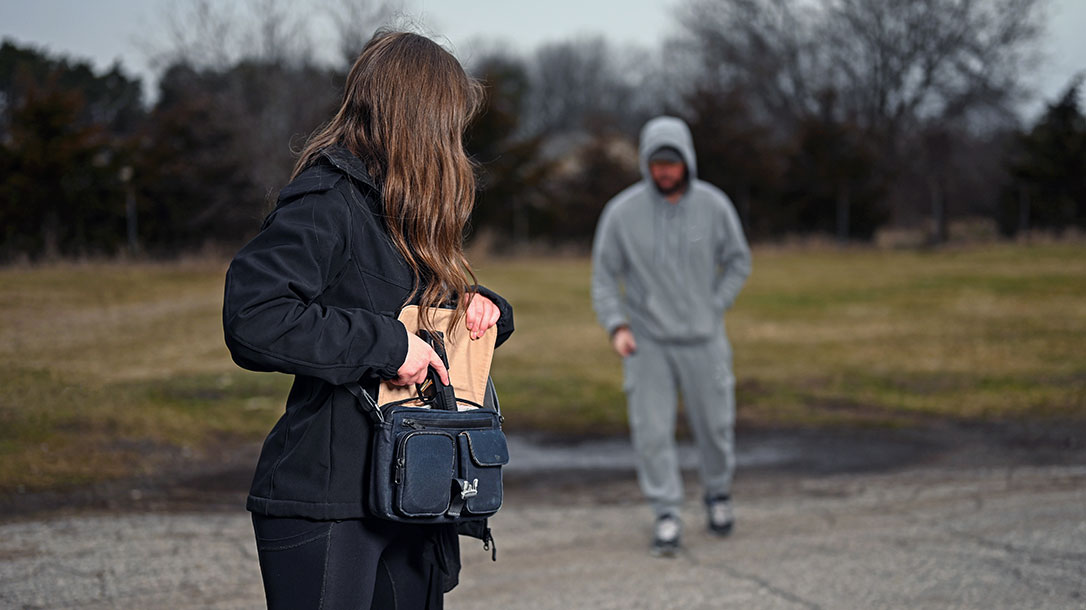A woman’s purse is a sacred treasure chest filled with our most precious belongings. It is the no man’s land of discarded receipts, forgotten snacks, unused gift cards, and extra lotions and potions. A purse is a rite of passage for all girls. However, women’s purses are also great places for carrying important self-defense tools.
Self-Defense Tools for Women: What’s in Your Purse?
From a young age of playing pretend to an adulthood of managing reality, we all quickly learn that our whole lives can fit inside these bags. It becomes more than an accessory but a means of protection. Specifically as a key to holding tools to keep us safe.
I always want to strengthen my odds of remaining safe, and would rather be overly prepared than under-prepared. My purse is an item I carry with me every day. So, why wouldn’t I use that accessory to my advantage?
Advertisement — Continue Reading Below
Lethal Versus Non-Lethal
Before I dive into what self-defense weapons our purse can hold, it is important we break those down into two separate categories—lethal and nonlethal.
Lethal tools can be described as any device, instrument, or material that’s able to deliver serious bodily harm or death. Examples of lethal tools are knives and firearms. However, tools such as baseball bats and clubs can also be considered lethal tools if used correctly.
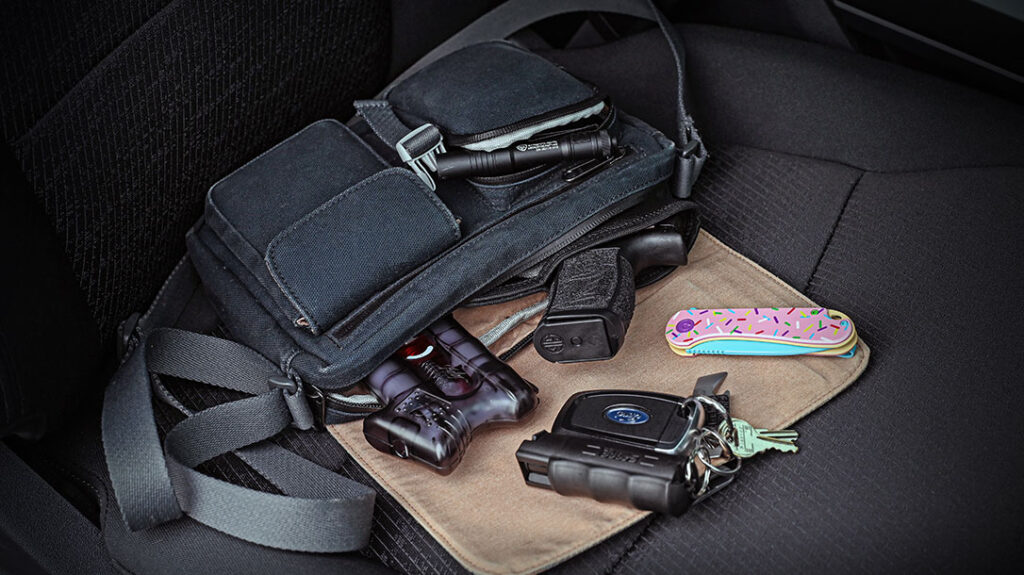
Advertisement — Continue Reading Below
A nonlethal tool is a device designed to momentarily incapacitate someone while minimizing fatalities. Some examples of nonlethal tools include pepper spray, tasers, and flashlights.
While I am unable to fit a baseball bat or a baton in my purse, thankfully, there are items that easily fit and keep me equally safe.
I want these tools to be quickly accessible in a moment that requires quick thinking. While carrying these tools in your hands keeps them prepared and at the ready, unfortunately, that’s not realistic.
Advertisement — Continue Reading Below
Do I really want to be carrying a taser around as I go grocery shopping? No, frankly, I do not. That would put a target on my back. A purse is an easy way to store your self-defense weapons so they may remain out of the way, unseen, and quickly accessible.
1. Pepper Spray
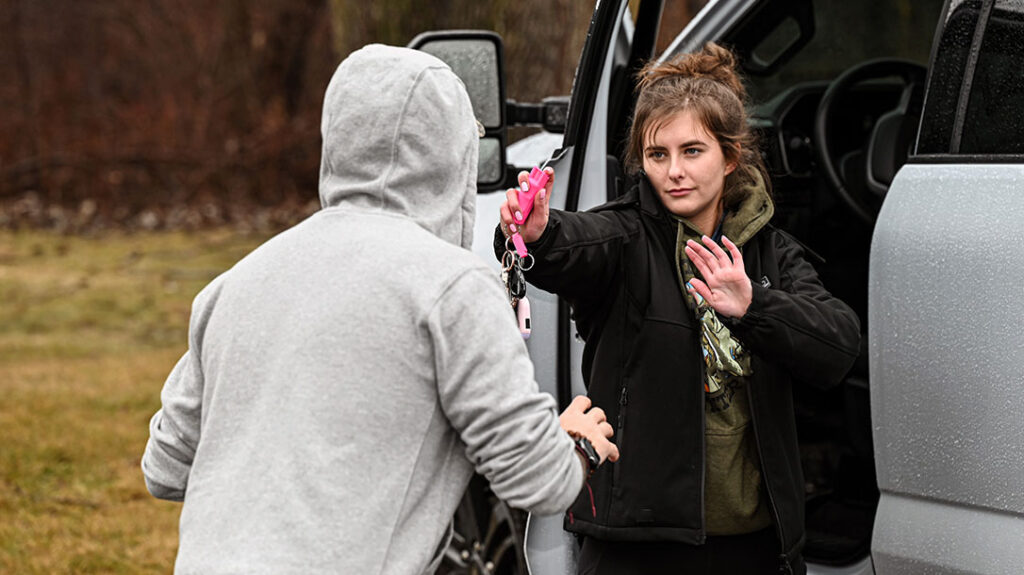
Pepper spray is a nonlethal weapon that should never be underestimated, no matter the size. The main ingredient in the spray is capsicum oleoresin. This is an oily resin that comes from capsicum genus, such as chili peppers.
Advertisement — Continue Reading Below
Adding that spiciness to someone’s face and eyes can cause burning, tingling, and temporary blindness. If inhaled, it can cause burning in the nose and throat, wheezing, and shortness of breath. These effects are not long-lasting but are everything I want to happen to an attacker to prioritize my safety.
Most canisters can spray from 10-14 ft and are incredibly easy to use. Before you carry this tool, it is important to practice and familiarize yourself with how the spray nozzle operates. Your thumb on your dominant hand should be used to press down on the nozzle firmly while your non-dominant hand is ready to push away an attacker.
While I am happy to report that pepper spray is legal in all 50 states, it is a good idea to be aware of restrictions in your state, county, and city. For example, states such as Wisconsin and California have some areas where only a certain percentage of capsicum oleoresin can be used in a canister.
Advertisement — Continue Reading Below
The most popular carry size amongst civilians is a 0.54-ounce canister. Specifically, because this small size makes it easy to store away in your purse when not in use.
2. Stun Gun
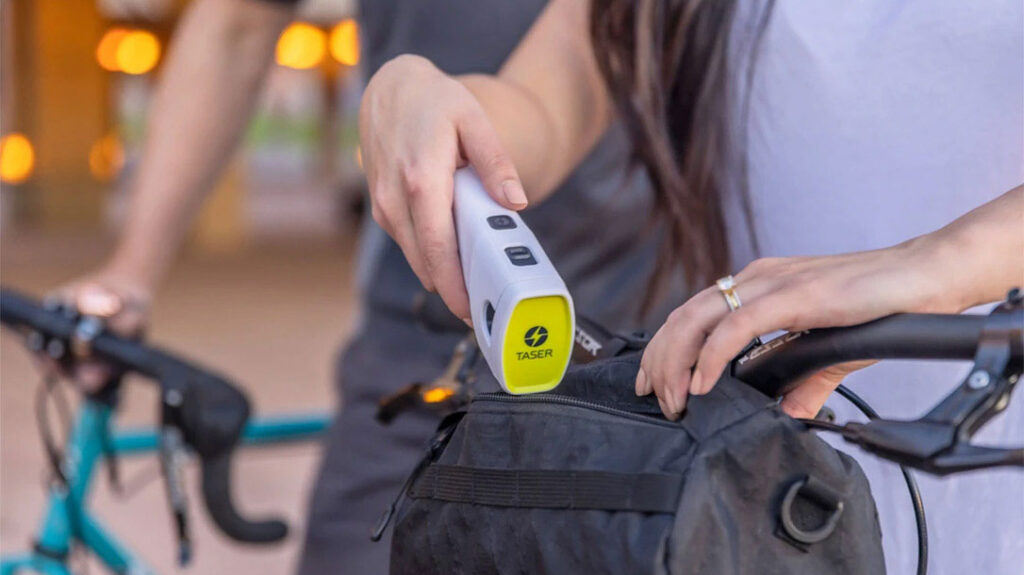
A stun gun is an electroshock weapon that is designed to deliver a temporary high-voltage electric shock. This tool attacks the nervous system, leaving the attacker disoriented and confused for up to several minutes. The energy from the shock is transferred into muscles, which causes the muscles to overwork and experience severe pain.
Advertisement — Continue Reading Below
A shock of up to three seconds can cause loss of muscle control. However, factors such as the attacker’s size can play a fundamental role. As a result, a larger attacker could require a longer shock time.
The best part about stun guns is if an attacker is touching you, the shock will not conduct from one person to another. It will only shock where contact is made and is designed to be held up against the body of an attacker.
Areas to aim for are the chest, stomach, thighs, and the back. These are targets that are not easy for your attacker to move away from the stun gun, as arms would be. Likewise, you can also aim for areas such as the face, if necessary, which will make a bad day for an attacker but a good day for you.
Advertisement — Continue Reading Below
Like with pepper spray, once your attacker is down, you should find a safe location and call for help.
It is important to note that not every state allows the use of stun guns as a form of self-defense. Currently, Rhode Island is the only state where the purchase, possession, and use of stun guns are illegal. Some states have restrictions on electroshock weapons, and it is best you research your state’s laws.
However, if legal in your state or jurisdiction, a stun gun makes a great addition to your purse for self-defense.
Advertisement — Continue Reading Below
3. Flashlight
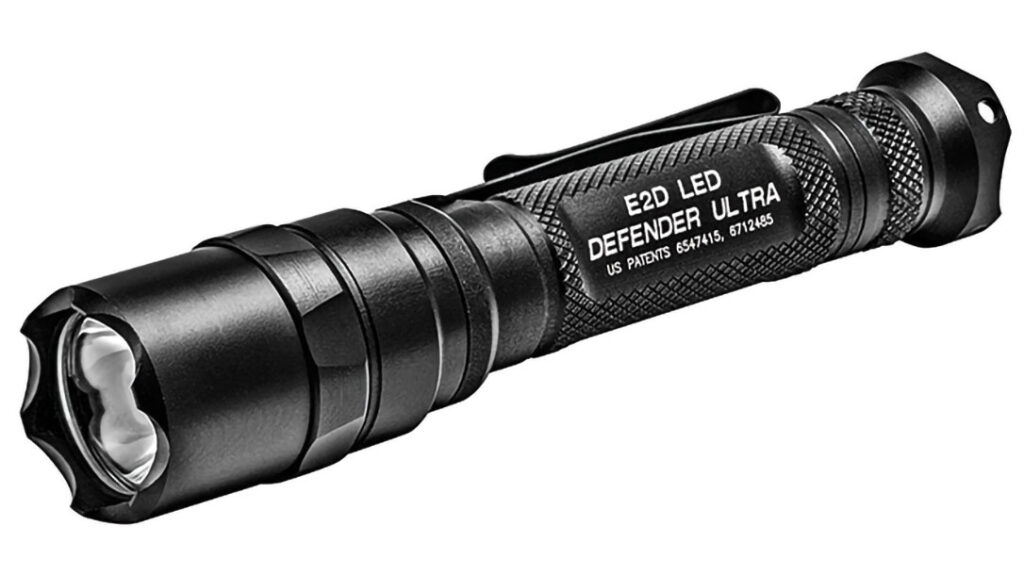
An attacker cannot attack if they cannot see, which makes a flashlight an excellent self-defense tool. However, not all flashlights can be used as blinding lights. They have to be the correct measurement of brightness.
We measure the total amount of light visible to the human eye from a light source in lumens—commonly referred to as light output. The higher the rating of lumens, the brighter the light source will be.
A flashlight with more than 100 lumens of light can cause distress to the human eye. At 150 lumens, you can temporarily blind an attacker at night. Likewise, a flashlight with 300 lumens allows you to temporarily blind an attacker during the day.
300 lumens are how many lumens are necessary for a flashlight to be considered a blinding flashing. However, I say the more lumens, the better.
The goal when using a flashlight for self-defense is to aim for the eyes and get away quickly. Flashlights are small enough to fit inside a purse or bag, making them a perfect self-defense tool to keep on hand.
4. Knife
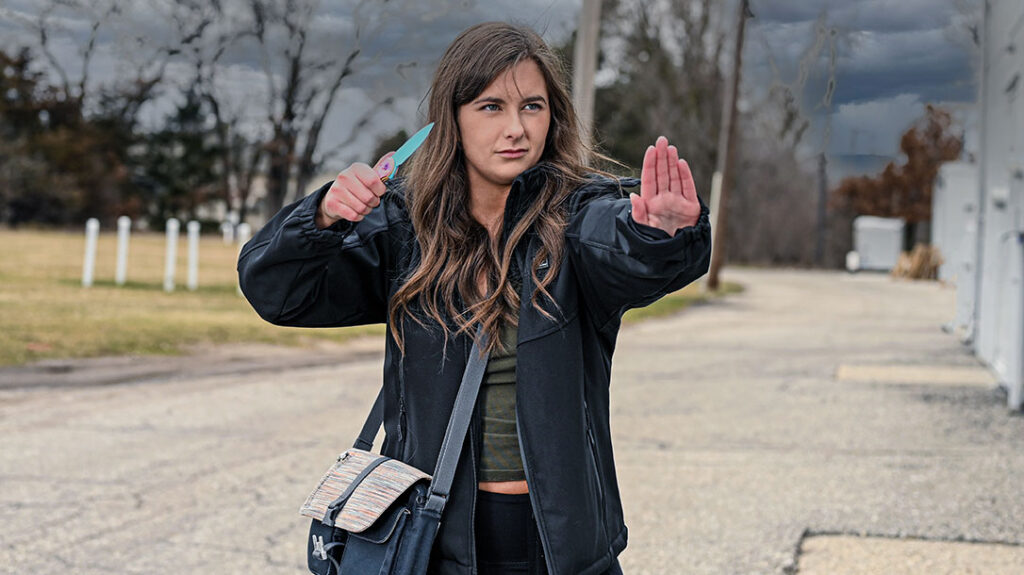
A knife has many uses, such as a helpful kitchen aid or box opener. But they also serve as a great tool for self-defense. Knives come in many different shapes, sizes, and types.
Pocket knives are a popular choice of knife and are designed to contain one or more blades that can be folded inwards to fit inside the knife handle. The typical blade length on a pocketknife can be up to 2-6 inches.
Areas to aim for are inside the forearms and wrists, triceps or biceps, and the front of the thigh right above the knee. There are two motions you can apply when using a knife to defend yourself—slashing or stabbing.
Slashing will create surface wounds that will cause immediate discomfort to an attacker while stabbing can cause long-lasting injuries.
Owning a knife is not illegal in the United States, but it is crucial you educate yourself on your state’s laws and regulations. These are lethal tools and should be treated as such.
KnifeRights.org is a great resource for checking your state and local laws and ordinances.
5. Handguns
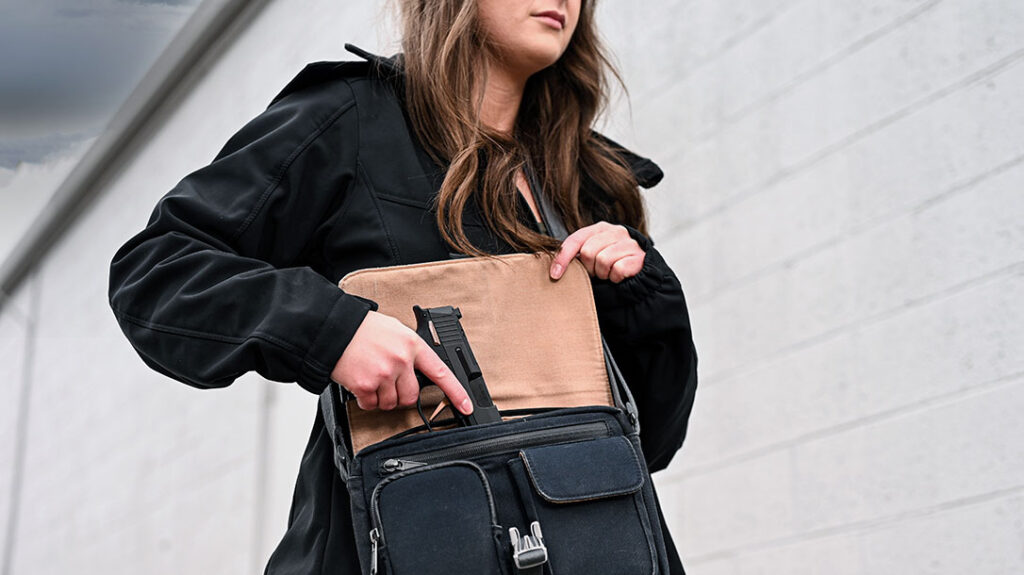
In my personal opinion, the most obvious self-defense tool is a handgun.
While each state has different laws concerning concealed carry, most states require a concealed firearm permit. This lethal tool requires a lot of practice to familiarize yourself with and can be a hobby that quickly turns into a lifestyle.
While carrying a firearm in a holster is a popular choice, purses can also do the same job for you. Yes, a regular bag will hold a firearm, but it will do a poor job of concealing it. Thankfully, concealed-carry purses are an option.
These purses are designed to conceal a firearm in a gun compartment crafted in a handbag. Fashionable and realistic to a gun-loving woman, they fit the job of keeping you and your firearm safe.
Self-Defense Tools for Women
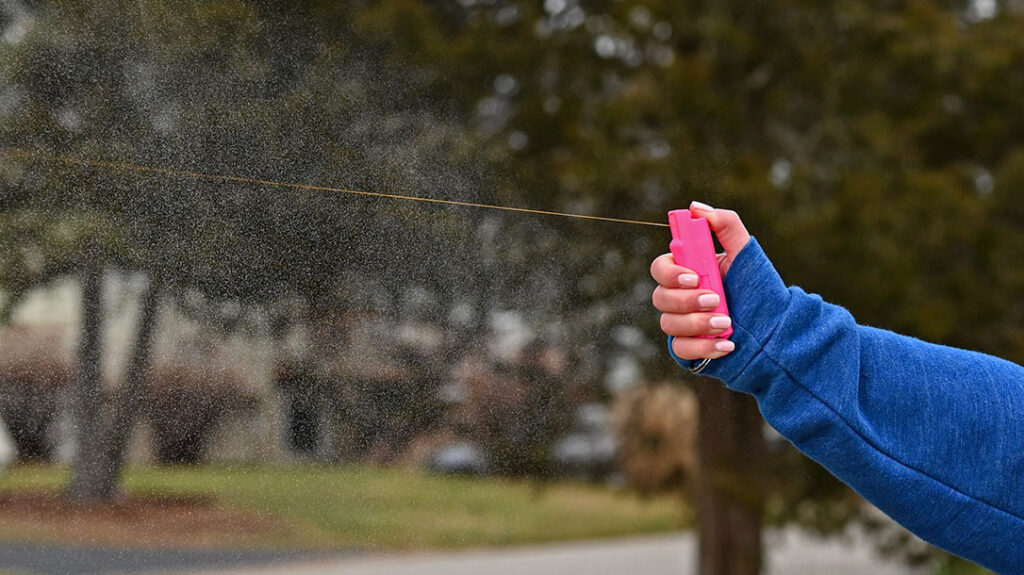
At the end of the day, remaining safe is my number one priority. The best way I can do that is by keeping tools on me to ensure it.
Now, realistically, I am unable to always carry my self-defense weapons around in my hands. However, my purse allows me to keep them close by until they are needed. Lethal or nonlethal, I have options to choose from, and so do you.
Self-defense weapons are not one size fits all. What may work for some may not work for you. The main goal is to use what feels comfortable and obey your state laws and regulations concerning each self-defense tool.
A quick Google search or visit to a gun shop or police department can get you up to speed on what is allowed and what is regulated in your state concerning each weapon.
Staying safe does not mean staying armed with every possible weapon available. Just use what realistically works for you. Personally, I only keep one tool in my purse, and that is my pepper spray. It works for me; I feel safe using it, and it helps me feel more confident in public.
Safety does not have to be a hassle. Sometimes, it can be as easy as using a leather-strapped bag wrapped in pretty colors to your full advantage.
